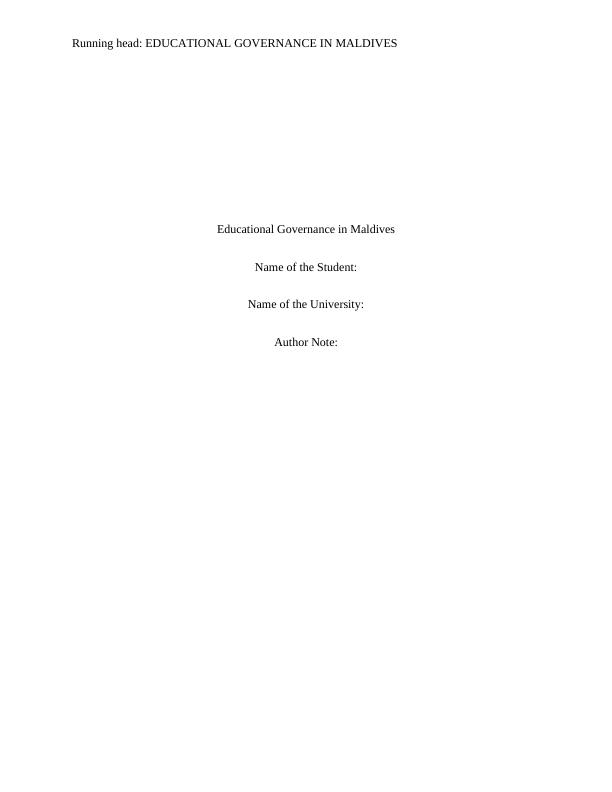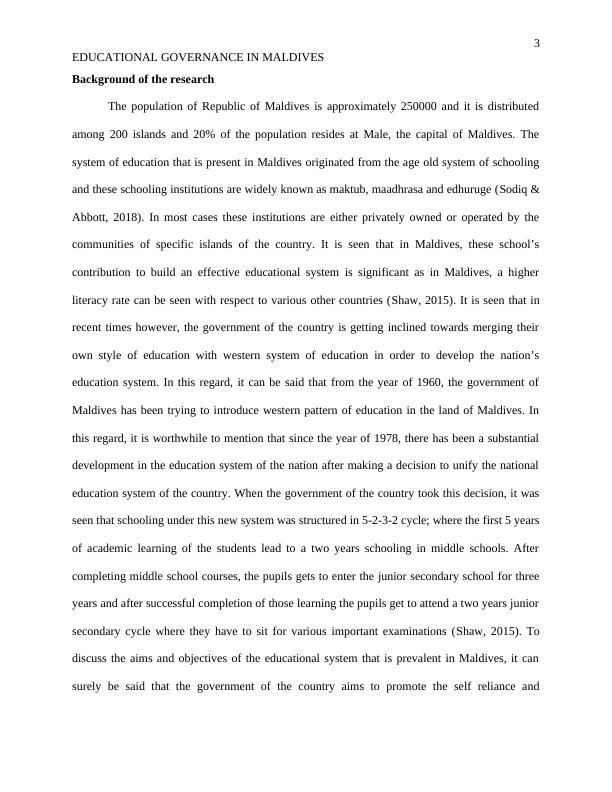Educational Governance in Maldives
Added on 2023-06-12
20 Pages5188 Words361 Views
Running head: EDUCATIONAL GOVERNANCE IN MALDIVES
Educational Governance in Maldives
Name of the Student:
Name of the University:
Author Note:
Educational Governance in Maldives
Name of the Student:
Name of the University:
Author Note:

1
EDUCATIONAL GOVERNANCE IN MALDIVES
Table of Contents
Introduction......................................................................................................................................2
Background of the research.............................................................................................................2
Governance in Maldives..................................................................................................................4
Constitutional right for education....................................................................................................7
Legal accountability in education and educational institutions:....................................9
Role of stakeholders......................................................................................................................11
Challenges in Educational Governance in Maldives.....................................................................12
Recommendation...........................................................................................................................14
Conclusion.....................................................................................................................................15
References......................................................................................................................................17
EDUCATIONAL GOVERNANCE IN MALDIVES
Table of Contents
Introduction......................................................................................................................................2
Background of the research.............................................................................................................2
Governance in Maldives..................................................................................................................4
Constitutional right for education....................................................................................................7
Legal accountability in education and educational institutions:....................................9
Role of stakeholders......................................................................................................................11
Challenges in Educational Governance in Maldives.....................................................................12
Recommendation...........................................................................................................................14
Conclusion.....................................................................................................................................15
References......................................................................................................................................17

2
EDUCATIONAL GOVERNANCE IN MALDIVES
Introduction
The Maldives Island is discrete and accessible in almost 1190 islands. Maldivian islands
are divided into 20 atolls and 7 provinces. Maldives is concentrated specifically on tourism,
fisheries, manufacturing and other related services which combine as its economic sector. The
system of education in Maldives is presented with the traditional system of the schooling that
lasted for several years. However, Maldives have been gradually improving its significant
concern in access to the education with confronting various challenges. The present system of
education in Maldives is present with the merging of the traditional and western schooling.
This study on educational context of Maldives is developed to address the concern of the
quality of the education in the Maldives. It will also help to understand the operating governance
plans and policies working for the education system in Maldives. The study also includes the
constitutional right for education in brief to gain a discussion of the perspectives along with the
legal accountability in education and educational institutions. The report will throw light over the
roles of the multiple stakeholders towards the contribution in the field of the education. The
report shows the key findings over identifying the challenges that are being faced by the
education sector. The involvement of the policy level, community, stakeholders groups and the
sharing to influence the policy discussions on improving education in Maldives will also be
provided in the report. In the end, the report will also present recommendations identified based
on the findings of the entire report.
EDUCATIONAL GOVERNANCE IN MALDIVES
Introduction
The Maldives Island is discrete and accessible in almost 1190 islands. Maldivian islands
are divided into 20 atolls and 7 provinces. Maldives is concentrated specifically on tourism,
fisheries, manufacturing and other related services which combine as its economic sector. The
system of education in Maldives is presented with the traditional system of the schooling that
lasted for several years. However, Maldives have been gradually improving its significant
concern in access to the education with confronting various challenges. The present system of
education in Maldives is present with the merging of the traditional and western schooling.
This study on educational context of Maldives is developed to address the concern of the
quality of the education in the Maldives. It will also help to understand the operating governance
plans and policies working for the education system in Maldives. The study also includes the
constitutional right for education in brief to gain a discussion of the perspectives along with the
legal accountability in education and educational institutions. The report will throw light over the
roles of the multiple stakeholders towards the contribution in the field of the education. The
report shows the key findings over identifying the challenges that are being faced by the
education sector. The involvement of the policy level, community, stakeholders groups and the
sharing to influence the policy discussions on improving education in Maldives will also be
provided in the report. In the end, the report will also present recommendations identified based
on the findings of the entire report.

3
EDUCATIONAL GOVERNANCE IN MALDIVES
Background of the research
The population of Republic of Maldives is approximately 250000 and it is distributed
among 200 islands and 20% of the population resides at Male, the capital of Maldives. The
system of education that is present in Maldives originated from the age old system of schooling
and these schooling institutions are widely known as maktub, maadhrasa and edhuruge (Sodiq &
Abbott, 2018). In most cases these institutions are either privately owned or operated by the
communities of specific islands of the country. It is seen that in Maldives, these school’s
contribution to build an effective educational system is significant as in Maldives, a higher
literacy rate can be seen with respect to various other countries (Shaw, 2015). It is seen that in
recent times however, the government of the country is getting inclined towards merging their
own style of education with western system of education in order to develop the nation’s
education system. In this regard, it can be said that from the year of 1960, the government of
Maldives has been trying to introduce western pattern of education in the land of Maldives. In
this regard, it is worthwhile to mention that since the year of 1978, there has been a substantial
development in the education system of the nation after making a decision to unify the national
education system of the country. When the government of the country took this decision, it was
seen that schooling under this new system was structured in 5-2-3-2 cycle; where the first 5 years
of academic learning of the students lead to a two years schooling in middle schools. After
completing middle school courses, the pupils gets to enter the junior secondary school for three
years and after successful completion of those learning the pupils get to attend a two years junior
secondary cycle where they have to sit for various important examinations (Shaw, 2015). To
discuss the aims and objectives of the educational system that is prevalent in Maldives, it can
surely be said that the government of the country aims to promote the self reliance and
EDUCATIONAL GOVERNANCE IN MALDIVES
Background of the research
The population of Republic of Maldives is approximately 250000 and it is distributed
among 200 islands and 20% of the population resides at Male, the capital of Maldives. The
system of education that is present in Maldives originated from the age old system of schooling
and these schooling institutions are widely known as maktub, maadhrasa and edhuruge (Sodiq &
Abbott, 2018). In most cases these institutions are either privately owned or operated by the
communities of specific islands of the country. It is seen that in Maldives, these school’s
contribution to build an effective educational system is significant as in Maldives, a higher
literacy rate can be seen with respect to various other countries (Shaw, 2015). It is seen that in
recent times however, the government of the country is getting inclined towards merging their
own style of education with western system of education in order to develop the nation’s
education system. In this regard, it can be said that from the year of 1960, the government of
Maldives has been trying to introduce western pattern of education in the land of Maldives. In
this regard, it is worthwhile to mention that since the year of 1978, there has been a substantial
development in the education system of the nation after making a decision to unify the national
education system of the country. When the government of the country took this decision, it was
seen that schooling under this new system was structured in 5-2-3-2 cycle; where the first 5 years
of academic learning of the students lead to a two years schooling in middle schools. After
completing middle school courses, the pupils gets to enter the junior secondary school for three
years and after successful completion of those learning the pupils get to attend a two years junior
secondary cycle where they have to sit for various important examinations (Shaw, 2015). To
discuss the aims and objectives of the educational system that is prevalent in Maldives, it can
surely be said that the government of the country aims to promote the self reliance and

End of preview
Want to access all the pages? Upload your documents or become a member.
Related Documents
Educational Governance in Maldiveslg...
|12
|700
|269
Impact of Current Advancements in the Educational Assignmentlg...
|24
|1552
|60
Campaign for Legal Awareness in Indialg...
|11
|3347
|27
Education Policy in Australialg...
|9
|2869
|466
About Colonialism and Canadalg...
|5
|1045
|11
Health Equity in Aboriginal and Strait Islander Young Maleslg...
|8
|2245
|43